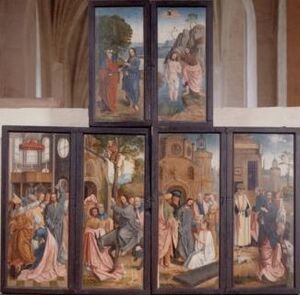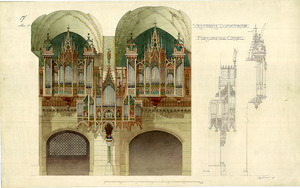Västerås Cathedral facts for kids
Quick facts for kids Västerås Cathedral |
|
|---|---|
| Västerås domkyrka | |

Västerås Cathedral
|
|
| 59°36′45″N 16°32′28″E / 59.61250°N 16.54111°E | |
| Location | Västerås |
| Country | Sweden |
| Denomination | Church of Sweden |
| Previous denomination | Roman Catholic |
| History | |
| Status | Cathedral |
| Dedication | Virgin Mary & John the Baptist |
| Consecrated | 16 August 1271 |
| Architecture | |
| Functional status | Active |
| Specifications | |
| Capacity | 1,100 (sitting) |
| Length | 93.2 m (305 ft 9 in) |
| Width | 34.4 m (112 ft 10 in) |
| Height | 91.8 m (301 ft 2 in) |
| Administration | |
| Diocese | Diocese of Västerås |
Västerås Cathedral (Swedish: Västerås domkyrka) is a very old and important church in Västerås, Sweden. It is the main church for the Diocese of Västerås. This huge building has five main sections inside, called aisles. It has a roof covered in copper and a tall tower at the west end. The tower has a unique, pointy spire that also shines with copper. The church is built in a special style called Brick Gothic, which was popular in Scandinavia.
History of Västerås Cathedral
The church you see today started as a smaller building in the 1200s. It was a Romanesque basilica, which means it had a long central area (the nave) and two side sections (aisles). This first church was officially opened on August 16, 1271. It was dedicated to the Virgin Mary and John the Baptist.
Over many years, the cathedral grew much larger. In the 1460s, Bishop Lydeke Abelsson helped expand the church towards the east. By 1517, a new chapel was added to the southwest corner. This made the church reach its current impressive size. The copper roof you see today was added in the 1600s.
The tall, pointy spire on the tower was designed in 1694 by a famous architect named Nicodemus Tessin the Younger. This spire is quite special because it's made of oak wood, without any iron beams or nails! It's covered in copper, making it stand out. Inside the church, many changes were made during the 1500s, 1600s, and 1700s to update its look.
A very important person, Johannes Rudbeckius (1581–1646), was the bishop of Västerås from 1619 until he passed away. The cathedral is also the resting place of Eric XIV of Sweden, who was the King of Sweden from 1560 to 1568. His sarcophagus, which is like a stone coffin, is kept here.
The Great Organ
The Västerås Cathedral is home to a magnificent pipe organ. When it was first built, experts praised it highly. They called it "one of the most significant" organs in Sweden. This amazing instrument was built by Åkerman & Lund in Stockholm. It was finished and approved on March 8, 1898.
When it was new, the organ had 40 different sounds, called "stops." It was one of the first large organs in Sweden to use a special system called "tubular pneumatic action." It also had five "high pressure stops," which create very powerful sounds. The beautiful front part of the organ, called the facade, was designed by Agi Lindegren.
Over the years, the organ has been made even bigger and better. In 1998, a company from England called Harrison & Harrison Ltd. worked on it. Then, in 2009, a Swedish company, Åkerman & Lund orgelbyggeri AB, made more updates. Even with these changes, the main part of the organ is still the one from 1898. The goal of these updates was to bring back the grand, original sound of the instrument.
Today, this impressive organ has 65 stops. It can be played using four different keyboards, called "manuals," and a pedalboard for the feet.
Gallery









